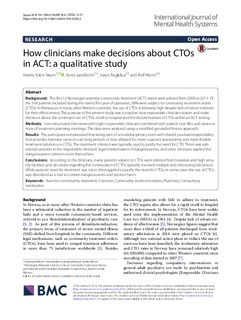| dc.contributor.author | Stuen, Hanne Kilen | |
| dc.contributor.author | Landheim, Anne | |
| dc.contributor.author | Rugkåsa, Jorun | |
| dc.contributor.author | Wynn, Rolf | |
| dc.date.accessioned | 2018-10-10T07:58:51Z | |
| dc.date.available | 2018-10-10T07:58:51Z | |
| dc.date.created | 2018-09-16T15:56:48Z | |
| dc.date.issued | 2018-09-22 | |
| dc.identifier.issn | 1752-4458 | |
| dc.identifier.uri | http://hdl.handle.net/11250/2567288 | |
| dc.description | Research article | en |
| dc.description.abstract | Abstract
Background:
The first 12 Norwegian assertive community treatment (ACT) teams were piloted from 2009 to 2011. Of the 338 patients included during the teams' first year of operation, 38% were subject to community treatment orders (CTOs). In Norway as in many other Western countries, the use of CTOs is relatively high despite lack of robust evidence for their effectiveness. The purpose of the present study was to explore how responsible clinicians reason and make decisions about the continued use of CTOs, recall to hospital and the discontinuation of CTOs within an ACT setting.
Methods:
Semi-structured interviews with eight responsible clinicians combined with patient case files and observations of treatment planning meetings. The data were analysed using a modified grounded theory approach.
Results:
The participants emphasized that being part of a multidisciplinary team with shared caseload responsibility that provides intensive services over long periods of time allowed for more nuanced assessments and more flexible treatment solutions on CTOs. The treatment criterion was typically used to justify the need for CTO. There was substantial variation in the responsible clinicians' legal interpretation of dangerousness, and some clinicians applied the dangerousness criterion more than others.
Conclusions:
According to the clinicians, many patients subject to CTOs were referred from hospitals and high security facilities, and decisions regarding the continuation of CTOs typically involved multiple and interacting risk factors. While patients' need for treatment was most often applied to justify the need for CTOs, in some cases the use of CTOs was described as a tool to contain dangerousness and prevent harm. | nb_NO |
| dc.description.sponsorship | The study was supported by a grant from Sykehuset Innlandet Hospital Trust (Grant No. 150242). | nb_NO |
| dc.language.iso | eng | nb_NO |
| dc.publisher | BMC | nb_NO |
| dc.rights | Navngivelse-Ikkekommersiell-DelPåSammeVilkår 4.0 Internasjonal | * |
| dc.rights.uri | http://creativecommons.org/licenses/by-nc-sa/4.0/deed.no | * |
| dc.subject | Assertive community treatment; | |
| dc.subject | Coercion; | |
| dc.subject | Community treatment orders; | |
| dc.subject | Compulsory medication; | |
| dc.subject | Psychosis; | |
| dc.title | How clinicians make decisions about CTOs in ACT: a qualitative study | en |
| dc.title.alternative | How clinicians make decisions about CTOs in ACT: a qualitative study | |
| dc.type | Peer reviewed | en |
| dc.type | Journal article | en |
| dc.description.version | publishedVersion | nb_NO |
| dc.rights.holder | © The Author(s) 2018. This article is distributed under the terms of the Creative Commons Attribution 4.0 International License (http://creat iveco mmons .org/licen ses/by/4.0/), which permits unrestricted use, distribution, and reproduction in any medium, provided you give appropriate credit to the original author(s) and the source, provide a link to the Creative Commons license, and indicate if changes were made. The Creative Commons Public Domain Dedication waiver (http://creat iveco mmons .org/ publi cdoma in/zero/1.0/) applies to the data made available in this article, unless otherwise stated. | nb_NO |
| dc.source.volume | 12 | nb_NO |
| dc.source.journal | International Journal of Mental Health Systems | |
| dc.source.issue | 51 | nb_NO |
| dc.identifier.doi | https://doi.org/10.1186/s13033-018-0230-2 | |
| dc.identifier.cristin | 1609868 | |
| cristin.unitcode | 1991,0,0,0 | |
| cristin.unitname | Sykehuset Innlandet HF | |
| cristin.ispublished | true | |
| cristin.fulltext | original | |
| cristin.qualitycode | 1 | |

